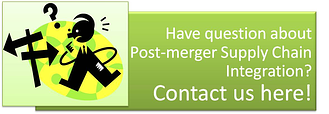If the Private equity people have their wallets open then they may benefit from some rich pickings.
While some M&A deals seem like they are made in heaven others are a disaster waiting to happen and often it is because the people signing the deal have not paid sufficient attention to the integration of potentially very different supply chains.  Failure to do this can turn successful companies into a chaos from which it is difficult to self-extricate. You cannot operate 2 discrete Supply Chains for long after a merger; you should plan Supply Chain integration even before the ink dries.
Failure to do this can turn successful companies into a chaos from which it is difficult to self-extricate. You cannot operate 2 discrete Supply Chains for long after a merger; you should plan Supply Chain integration even before the ink dries.
Unless you are overflowing with surplus resources do yourself a favour and get somebody else to plan and execute the integration. Your existing people will still be doing their day jobs (and worrying about job security!) and will not have time to step back, look at the big picture and move the right levers at the right time.
A few key focus areas:
IT - is each entity running SAP or another common system? Evaluate both, chose the optimum system and migrate to it. You can spend hours arguing about which system to migrate to so providing they are top class IT solutions simply evaluate both, choose one quickly and move on.
S&OP - In some cases it can be advantageous for neither of the merger parties to operate a robust S&OP. Implementing such a process jointly can provide a huge step forward in the integration process and staff camaraderie. If S&OP is already active there is no harm in taking the best elements from both and moulding a freshly agreed process with widespread buy-in.
Warehousing & Logistics - Do not try and integrate these ahead of the IT and S&OP changes. There is no harm in allowing warehouses to operate in parallel for some time. Once you have your business processes stabilised you can move ahead to integration, simplification and cost saving here.
Distribution/RTM - many different Route To Market models exist and careful planning is needed when changing any aspect of customer/consumer interaction. Do you service Key Accounts direct? Do you need all those Distributors? A merger is an ideal opportunity to thoroughly evaluate the newly combined Distributor cadre. Some will obviously be better than others but you need a scientific and unemotional tool to assess this critical function.
Learning to live with a new partner is never going to be easy but you can minimise the stress by taking steps to integrate Supply Chains in a timely fashion.








